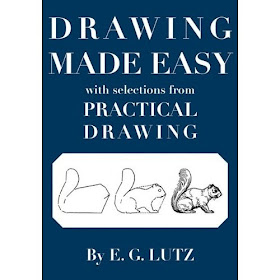 First published in 1921, Drawing Made Easy taught millions of people to draw, and it’s the one that taught me. Now Darren Rousar, a prominent instructor of academic sight-size drawing has brought it back into print.
First published in 1921, Drawing Made Easy taught millions of people to draw, and it’s the one that taught me. Now Darren Rousar, a prominent instructor of academic sight-size drawing has brought it back into print.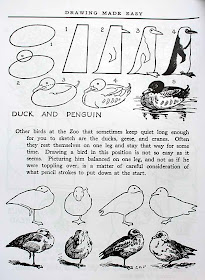 Drawing Made Easy uses a sensible approach. Each drawing begins with simple, easy-to- comprehend shapes and proceeds to details last, essentially the same method used in the 19th century academies.
Drawing Made Easy uses a sensible approach. Each drawing begins with simple, easy-to- comprehend shapes and proceeds to details last, essentially the same method used in the 19th century academies.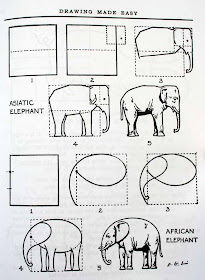
Each drawing is presented in a series of straightforward and memorable stages. The subjects are people, animals, flowers, and charmingly antique trains and cars.
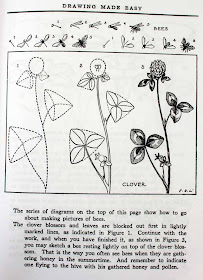 The beginning student—either child or adult—progresses to fairly challenging subjects by the end. That clover would be difficult to get right without the analytical method that Lutz presents. This new edition also includes a few key chapters from Lutz’s intermediate book, Practical Drawing, which covers the proportions of the figure and the management of light and shade to produce form.
The beginning student—either child or adult—progresses to fairly challenging subjects by the end. That clover would be difficult to get right without the analytical method that Lutz presents. This new edition also includes a few key chapters from Lutz’s intermediate book, Practical Drawing, which covers the proportions of the figure and the management of light and shade to produce form.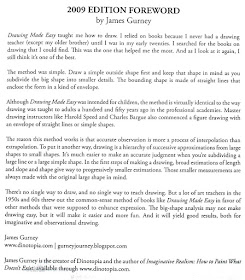 When Mr. Rousar asked me to contribute the foreword to this edition, I was thrilled. Here’s what I wrote (click to enlarge).
When Mr. Rousar asked me to contribute the foreword to this edition, I was thrilled. Here’s what I wrote (click to enlarge). If this post sounds like an ad, it is! I would love to share this book with people who want to learn to draw, whether they are adults or children. You can order a copy directly from me by sending a check payable to "The Dinotopia Store" for $14.95 plus $3.50 shipping ($18.45 total).
Mail to The Dinotopia Store, PO Box 693, Rhinebeck, NY 12572. (USA residents only, NYS residents, please add sales tax). Here’s an order form you can print out and send.

Looks good; a worthy companion to my "Learn to Draw" kit by Jon Gnagy. In the early 50s, Mr. Gnagy delivered me to a world of cubes, cones, and spheres that still shapes my reality.
ReplyDeleteHi, do you take Paypal as a form of payment for the book?
ReplyDeleteHi, John, I'd like to, but I just don't have it set up in a way that's practical for keeping records. Hope you don't mind using the paper method.
ReplyDelete88 years old and still running with the best of them! It's a great book. Thanks for sharing...and fantastic introduction!
ReplyDeleteIn college in the 60's I learned "contour drawing" where you look at the subject and not at the paper, and draw every line. You ended up with very expressive drawings in which the proportions could be all off. It was drawing the details and letting the whole picture take care of itself, something I tended to do anyway. Contour drawing was an exercise in seeing, not a method of doing pictures, but it stuck with me.
ReplyDeleteI never learned the method described in this book, of blocking in the whole and then putting the details in little by little (though I believe the Walter Foster books which I had as a child taught drawing that way). I always put in the trees--or rather the twigs and leaves--and hoped the forest would appear. But when you concentrate on the details, they start getting bigger and bigger, and then you lose the relationship of one part to another.
So I was in college just at the right time to learn that expressiveness was better than realism. I wish I had learned early the method that this book teaches. But I'm learning it now--better late than never.
Your brother Dan gave me the link to find you today. Book looks like many classics - forever relevant. Interesting post.
ReplyDeleteThanks! Looks great. And for those of us who have no idea what NY sales tax might be (as it apparently changes every few miles), here's a calculator: http://www.earthodyssey.com/sales_tax.html
ReplyDeleteThanks, Gordon...that was really thoughtful to give the link to the sales tax calculator.
ReplyDeleteVicki, you explained perfectly the benefits and limitations of the contour drawing approach. Some really excellent beginning drawing books, like Drawing on the Right Side of the Brain, use a modified form of contour drawing to give people who haven't drawn much before the feeling of right-brain seeing.
But for accurate observational drawing--and also imaginative drawing and cartooning--the shape analysis system is much more useful.
Wow, just a few hours ago I was searching for a book about drawing and here it is. My order will be on the way.
ReplyDeleteShame you can't serve international customers... are there any alternatives for people from the other side of the Pond?
ReplyDeleteThere is also a good Lutz book about animation., called "Animated Cartoons". It is said that Disney learned from this. It is still good for basic walk cycles.
ReplyDeleteBoth books are available from Amazon.
Wow! I grew up learning how to draw with this book. It was my father's and I knew every page.
ReplyDeleteThanks for telling me it was available again. I lost it somewhere along the way.
Lynne
Thank you. Cheque will be in the mail.
ReplyDelete